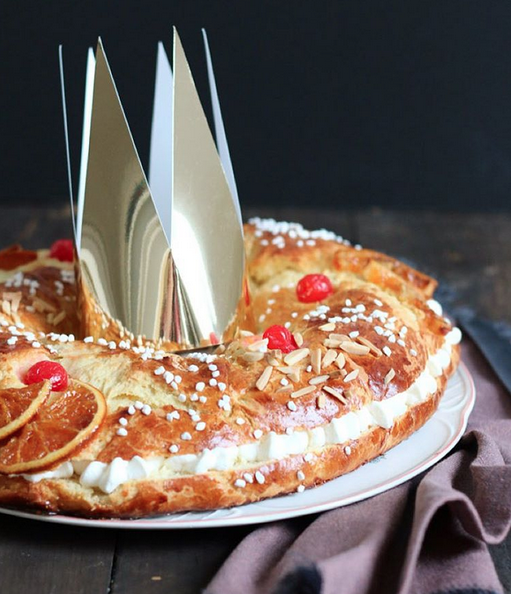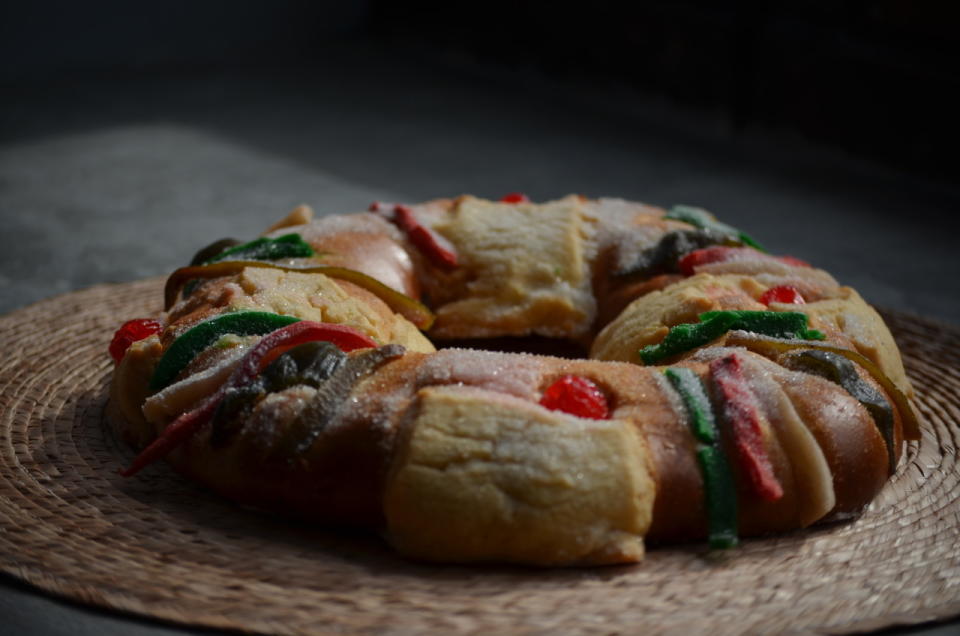The History of Rosca de Reyes King’s Cake (and How to Make It)

The traditional Rosca de Reyes is served as a celebration of the King’s Day in many cultures. (Photo: @baketotheroots)
While for many, the beginning of the New Year means taking down the tree, tossing out mounds of wrapping paper, and removing twinkle lights, for some cultures the Christmas season is still in full force. January 6 marks the El Dia de Reyes, or King’s Day, which celebrates the arrival of the three wise men in Bethlehem and the day Jesus was baptized by John the Baptist. In Spain, Latin America, and many Hispanic communities in the U.S., children open gifts, parties are thrown, and joyous guests dig into one sweet special treat: the Rosca de Reyes. The Rosca de Reyes, or King’s Ring, consists of an oval of sweet, chewy egg bread, often filled and dressed with figs, quinces, cherries, or dried and candied fruits.
Though most have heard of a Louisiana-style King Cake — a buttery French bread dough laced with cinnamon and sugar and concealing a plastic baby, typically eaten during the Carnival season — the Rosca de Reyes is a lesser-none royal treat. However, the two cakes share similar origins and traditions.
More: Make a Louisiana King Cake at Home
Also known as the Gallette de Rois in southern France or the Tortell in Catalonia, where the holiday is also celebrated, this festive treat has a long and diverse history that dates back to the middle ages. The tradition of hiding figures within the dough represents the flight of the Holy Family during King Herod’s Massacre of the Innocents, and the reward for finding the figurine varies from culture to culture. For some, whoever finds the baby Jesus is considered blessed and must take the figure to the nearest church. For others, the finder is declared King and thus responsible for hosting a dinner of tamales and atole for their guests on February 2, also known as Candlemas, or the day the infant Jesus’ was blessed in the temple.
“The children of Mexico look forward to this holiday as traditionally, gifts are exchanged on this date, not Christmas day,” says Chef Roberto Santibañez of FONDA restaurants in NYC, who adds a King’s Ring Cake to his menus from January 5-10 as an ode to this beloved childhood tradition. Throughout Texas, Roscas De Reyes are also a popular bakery item in early January, as many of the Latino population prepare to celebrate the holiday. While some keep the cake simple, others get creative, stuffing their dough with fruity fillings, cream and cajeta cheese.
More: Cardamom Almond King Cake Recipe
In French culture, the youngest child is blindfolded and sits under the table as the King’s Cake is served, blindly assigning slices of the cake to different family members, each hoping to uncover the porcelain nativity trinket within. Clemence Danko, owner of Choc O Pain Bakeries in New Jersey, keeps this playful tradition alive by serving a Gallette de Rois with a light frangipane filling all January long.
Whether served stuffed, sliced, or coated in candied citrus rinds, this Epiphany dessert is a favored tradition for many — especially those lucky few who unearth a little plastic deity and become ruler of the cake kingdom for a day.
To learn how to make your own Rosca de Reyes, check out Chef Roberto Santibañez’s recipe below.

Chef Roberto Santibañez’s interpretation of the Rosca de Reyes. (Photo: Courtesy of FONDA restaurants)
Rosca de Reyes (King’s Ring Cake)
By Chef Roberto Santibañez of FONDA restaurants
Makes: 4 pieces (2 pounds, 6 ounces of dough)
Serves: 8 to 12 servings
4 cups (18 oz) unbleached all purpose flour, divided
¾ cup goat’s milk
3 teaspoons (1.5 envelopes) dry active yeast
½ cup (4 ounces) sugar
3 large eggs
3 large egg yolks
2 teaspoons vanilla extract
1 ½ teaspoons ground Mexican cinnamon
1 tablespoon orange flower water
1 ½ teaspoons salt
4 tablespoons (2 ounces) butter, very soft
4 tablespoons (2 ounces) lard, very soft (or substitute more butter)
4 baby Jesus statuettes or dried beans, each wrapped in white paper
Strips of candied orange peel, stemmed quarters of dried figs, and candied cherries; if available strips of candied Biznaga cactus (barrel Cactus)
Melted butter for brushing the baked loaves
Superfine sugar for sprinkling
In a small saucepan heat the goat’s milk until just warm, no more than 110 degrees. Pour into a bowl and quickly whisk in the dry yeast to avoid lumps. Use a rubber spatula to smoothly stir ¾ cup of the flour into the yeast and milk mixture. Cover the bowl with plastic wrap and let the sponge ferment until very light and bubbly, up to an hour.
Scrape the sponge into the mixer bowl and use a rubber spatula to stir in the sugar, eggs, yolks, flavorings, and salt. Gradually stir in the remaining flour. Place the bowl on the mixer with the paddle attachment and beat on medium speed until soft and well mixed. Carefully scrape the bowl and beater and beat again for 2 minutes longer. Scrape again and beat in the lard and butter in about 8 separate additions, continuing to beat the dough until it is very smooth and elastic, about 2 or 3 minutes longer.
Cover the bowl with plastic wrap and allow the dough to rise until it is double in volume, about an hour.
Scrape the dough to a floured surface and fold the dough over onto itself several times to make it slightly more elastic. Shape the dough into a cylinder and cut it into 4 equal pieces. Round off 4 of the pieces to be the loaves and set on a floured work surface to rest, covered with a cloth, for 5 minutes.
To shape, gently pierce an opening in the center of each, widening it to about a 5- to 6-inch diameter. Seat each loaf thus pierced onto a paper-lined sheet pan (or 2 smaller pans), gently stretching each to an oval shape. Pierce each loaf on the side and insert one of the wrapped statuettes or beans. Brush with butter and decorate with the dried and candied fruit.
Cover the formed loaves with a towel and allow them to rise until about 50% increased in size.
About 20 minutes before the loaves are risen set a rack in the middle level of the oven and preheat to 350 degrees. Bake the loaves until they are a deep golden color and feel light for their size, about 30 minutes.
Transfer the baked loaves to racks to cool for a few minutes, then brush them with the butter and immediately sprinkle generously with the sugar. Let the loaves cool completely and serve them within 24 hours.
In the mood to bake? Try these recipes, too:
Rich and Fudgy Flourless Apple Cake
Southern-Style Red Velvet Cheesecake
Salted Caramel Apple Snickers Cake

